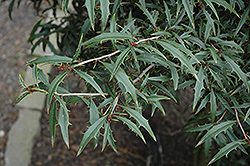It's all about ...
plants

William Hawkins American Holly
Ilex opaca 'William Hawkins'
Height: 15 feet
Spread: 8 feet
Sunlight:
![]()
![]()
Hardiness Zone: 5a
Description:
Unusually narrow and spiny evergreen foliage, the leaves are more lustrous than the species; its shrubby, dense form is a good fit for smaller landscapes; does best in evenly moist, acidic soil
Ornamental Features
William Hawkins American Holly is primarily valued in the landscape for its ornamental upright and spreading habit of growth. It has attractive dark green evergreen foliage. The large spiny narrow leaves are highly ornamental and remain dark green throughout the winter.
Landscape Attributes
William Hawkins American Holly is a dense multi-stemmed evergreen tree with an upright spreading habit of growth. Its relatively coarse texture can be used to stand it apart from other landscape plants with finer foliage.
This tree will require occasional maintenance and upkeep, and is best pruned in late winter once the threat of extreme cold has passed. It is a good choice for attracting birds and bees to your yard. It has no significant negative characteristics.
William Hawkins American Holly is recommended for the following landscape applications;
- Mass Planting
- Hedges/Screening
- General Garden Use
- Naturalizing And Woodland Gardens
Planting & Growing
William Hawkins American Holly will grow to be about 15 feet tall at maturity, with a spread of 8 feet. It has a low canopy with a typical clearance of 1 foot from the ground, and is suitable for planting under power lines. It grows at a slow rate, and under ideal conditions can be expected to live for 50 years or more.
This tree does best in full sun to partial shade. It requires an evenly moist well-drained soil for optimal growth. It is particular about its soil conditions, with a strong preference for rich, acidic soils. It is somewhat tolerant of urban pollution, and will benefit from being planted in a relatively sheltered location. Consider applying a thick mulch around the root zone in winter to protect it in exposed locations or colder microclimates. This is a selection of a native North American species.
This plant is not reliably hardy in our region, and certain restrictions may apply; contact the store for more information.
